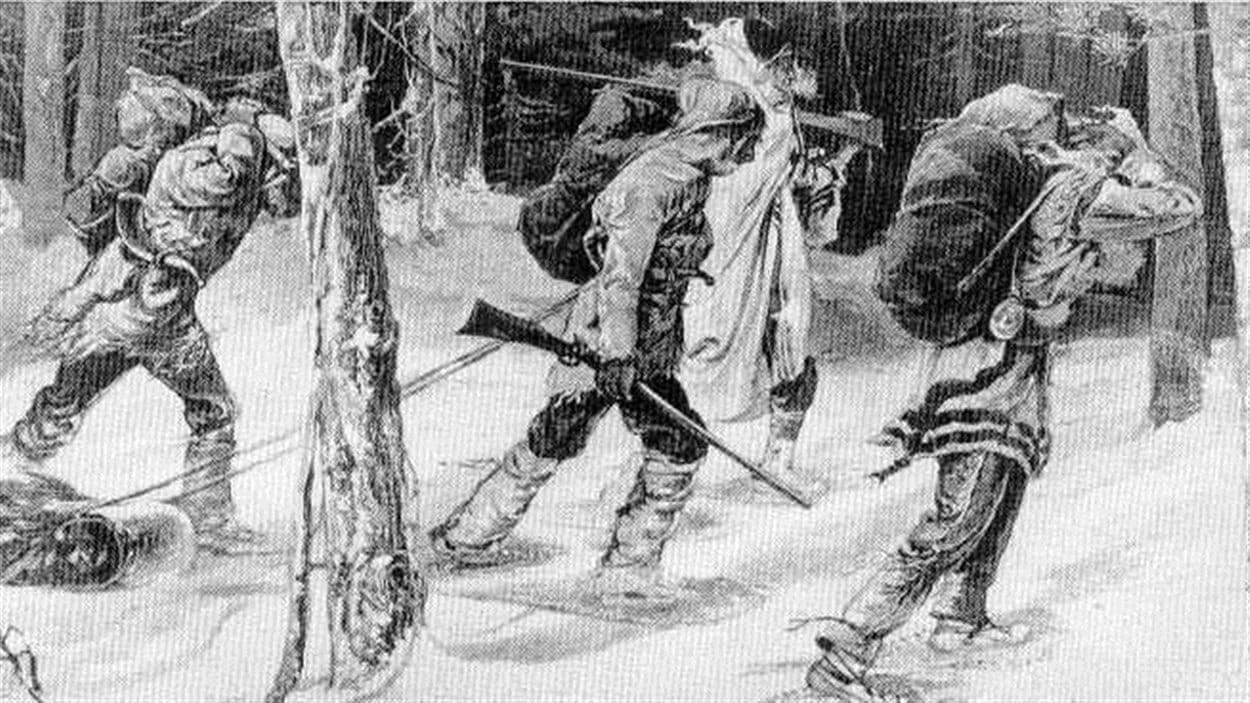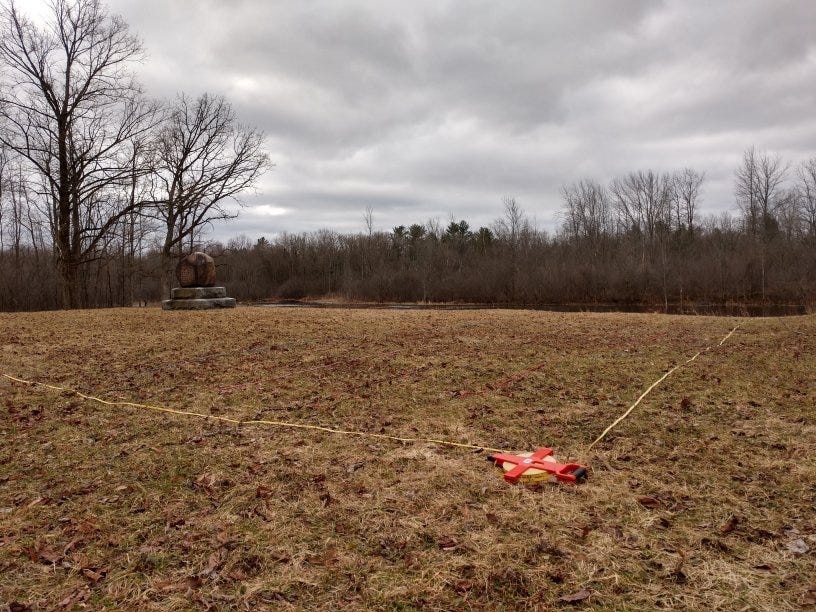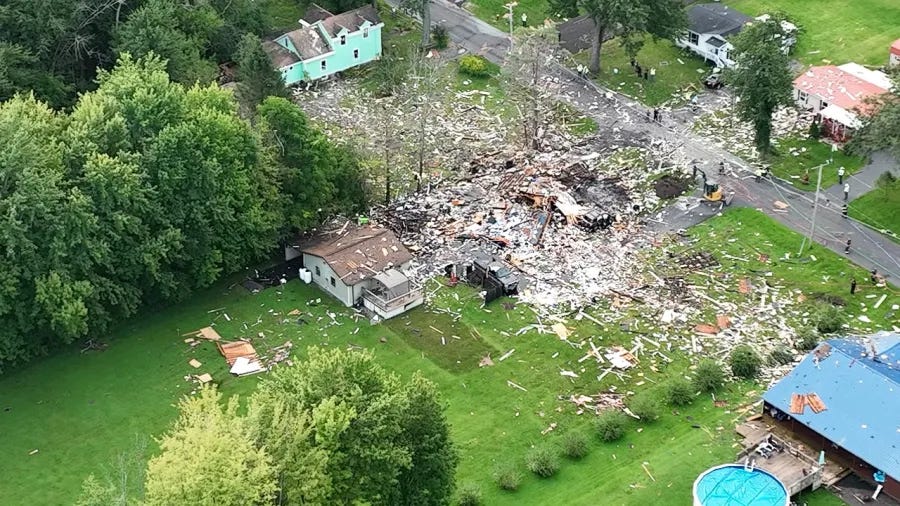I was going to write about some of my hands-on history experiences this summer, but then the nearby sleepy town of Oneida, NY got blown up. And all I could think was, “Not again!”
What happened was that a teenager drove a car through a house, as they do. And he ruptured the house’s gas line, and the house exploded. Go see it here if you want video.
This is not the first time Oneida has exploded, though. The first time was when the French destroyed it in 1756. I suppose I’m stretching things a bit when I say the town keeps exploding, but seriously, how often has your town been blown up? If I had a nickel for every time Oneida exploded …
It’s very difficult to blow up a town in 1756. How did the French pull it off? Sure, they could park a warship off the coast and bombard a town with cannon fire, but Oneida is in Central New York, 260 miles from the Atlantic Ocean. To this day, there is some question of whether the French even meant to explode the town. For fun, try to guess what they used to create the cataclysm, and read on to see if you’re right.
The French raiding force did not have an easy time getting to Oneida. Heh. We Western and Central New Yorkers love that. Like every population forced to live in arctic conditions, we want it to weaken you. Just as we live for the Buffalo Bills trouncing Miami in December snowstorms, we giggle over stories of General Burgoyne in the Revolutionary War being snowed under on his way to Saratoga. I don’t know what people expect when they decide to walk from Canada to New York in the winter, which doesn’t end until early May, but I don’t advise it. If anyone could do it in 1756, though, it was the Canadians and their Canadian Iroquois allies, who decided to start the trip in March to prove their winter warrior bona fides.
As to why Oneida, the short answer is that Oneida supplied Fort Oswego, Britain’s only outpost on Lake Ontario. The long answer is “portage.” In fact, most of the New York State fronts of the war are portage stops, portage stops, and also portage stops. I often wonder if I could go back in time and win this front of the war with an off-road vehicle and a case of Wegmans’ granola bars.
Anyway, the French assembled 366 men led by Lieutenant de Lery, an engineer who had earned his winter warrior merit badge in 1750s Detroit, so he was no spoiled Parisian poodle. You really didn’t want to anger the Canadian militia and their coureurs de bois while the snow fell; nobody could winter war like they could. The 366 men included 166 Canadian militiamen and about 100 Canadian Iroquois, to lead the way and take the blame. It took them almost the entire month of March 1756 to walk from Watertown NY to Oneida. They ran out of food and ate their horses. This trip currently takes an hour and a half on the NY Thruway; I wasn’t kidding about the off-road vehicle and the granola bars.

The French force arrived at Fort Bull in Oneida on March 26. They attacked the fort, hacking at its gate for over an hour. At last, the gate gave way. De Lery and his men rushed into Fort Bull, shouting “Vive le roi!”, and were met by the British defenders’ musketry fire and grenades. De Lery’s men charged with bayonets and tomahawks. De Lery reported that he “would not moderate the ardor of the soldiers and the Canadians. They killed whoever they came upon.” Some British soldiers managed to escape into the barracks, where they put up fierce resistance. However, fire now erupted in one of the fort’s buildings. De Lery ordered his men to get out of the fort as fast as possible.
They had only run 770 ft (235 m) out of the fort when it blew up in 3 powerful explosions. The force was so great, de Lery wrote, that the “whole detachment was thrown off the ground.” In an instant, the fort, its buildings, and the unfortunate people within were utterly destroyed. De Lery and his men were awed at the destruction’s extent. Where less than a minute before, Fort Bull had stood, there was now nothing but debris. De Lery notes there was a very large quantity of alcoholic spirits in the storehouse’s cellars because the flames had a blue hue.
Yup, they blew it up with good old English rum. The fire destroyed all the rations bound for Lake Ontario: rum, salted pork, biscuits, butter, chocolate, and clothing. Yes, the British Army was rationed chocolate in 1756. Sort of a charming detail. I have my doubts about the rum, in that I suspect much of it was sold to Indians rather than rationed, but I can’t prove anything.
You probably haven’t heard about this first destruction of Oneida, but that doesn’t mean America isn’t still salty about it. The State University of New York at Binghamton is busy excavating the site of the former Fort Bull, and has this to say about it: “The attack on Fort Bull on March 27, 1756 was devastating, debilitating, and demonstrative. ... The violent destruction of the fort and slaughter of its defenders illustrated the fragility of the supply network. Ultimately, this attack on the Oneida Carry and Fort Bull led to an under supplied, under manned garrison at Fort Oswego when it was captured by Montcalm in August 1756.”
I did not visit the site this summer, as SUNY Binghamton is discouraging people from digging up artifacts and such while they are surveying. It’s just an empty field with a commemorative plaque right now. We’re not exactly sure where Fort Bull was because other forts were immediately built in Oneida to protect this vital portage link. Much of the French and Indian War activity in this area was burning forts and rebuilding forts over and over and over, and in fact this continues through the War of 1812. (If I can complain for a moment, it’s very confusing. One day I’m reading about Fort Ontario, the next day I’m reading about Fort Oswego in the same damn town. Are they the same fort? How many Fort Ontarios were there?)

If you have the opportunity, I recommend visiting Fort Oswego / Ontario in Oswego, NY. It’s a very fun historical site. Kids will love it as there’s lots of room to run over and under and inside the earthworks. Oswego is an adorable lakeside town with a rich history. Oneida … well, it’s a nice place when it’s not exploding.
References:
https://www.nps.gov/places/fort-bull-fort-wood-creek.htm
https://www.binghamton.edu/programs/public-archaeology-facility/projects/fortbull/index.html
Chartrand, R. Montcalm’s Crushing Blow. Osprey Publishing, Ltd. Oxford, UK. 2014.
Rene Chartrand, wherever you are, this book you wrote on the raids on the Oswego River in 1756 is incredible. I found this book in the gift shop at Fort Oswego. Historical site gift shops are fantastic places to find sources. Anyway, thank you, Monsieur Chartrand, and an especial thank you to your 3 illustrators.




Oneida may have exploded, but 120 years later it was reborn as a commune notable for free love and later the manufacture of silverware. Talk about perseverance.
Great read, Kate. And regarding your glee about Western NY winters, as a NH native I note winter (from Halloween until the Mayflies hatch) is ‘the other half’ of the year!